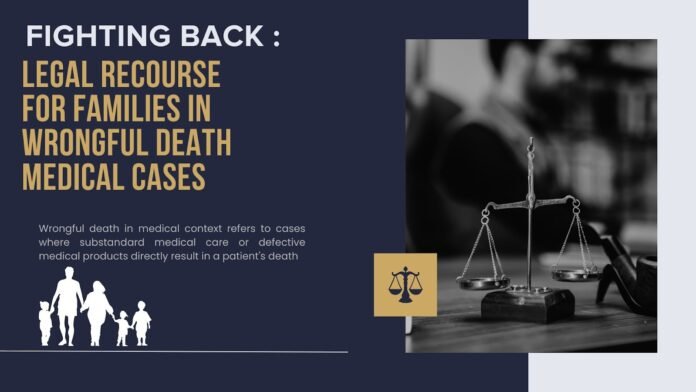Last Updated on July 14, 2024 by Asfa Rasheed
Losing a loved one is painful enough. But when their death is caused by medical negligence, families can face compounded grief, financial stress, and the agonizing reality that better care could have prevented their loss. While the complex legal system cannot replace lost lives, it does offer pathways for justice and compensation through medical malpractice and product liability claims For families seeking accountability and means of moving forward, It is essential to understand these legal avenues.
Table of Contents
Understanding Wrongful Death Cases in Medical Context
Wrongful death in medical context refers to cases where substandard medical care or defective medical products directly result in a patient’s death. Here are some key statistics regarding wrongful deaths linked to medical errors:
– Medical errors are the third leading cause of death in the United States, causing over 250,000 fatalities annually. (Source: Johns Hopkins Medicine)
– Approximately 1 in 10 deaths in the United States stems from preventable medical errors. (Source: Agency for Healthcare Research and Quality)
These alarming figures highlight the devastating impacts of medical negligence. But defining the specific forms of errors that precipitate wrongful death equips families to seek justice. Once families are well educated on what exactly wrongful death is, they can seek justice in the right places. For instance, families in Nevada can seek the assistance of a wrongful death attorney Reno, NV, to explore these legal avenues for recourse.
Identifying Forms of Medical Negligence
Wrongful death in healthcare often links to:
Surgical Errors and Complications
Botched surgeries claim around 4,000 lives annually in the U.S. Surgical mistakes like operating on the wrong site or leaving foreign objects inside patients can prove fatal. (Source: Patient Safety Network)
Misdiagnosis and Delayed Diagnosis
Failing to diagnose conditions or delayed diagnoses affects over 12 million Americans yearly, allowing treatable diseases to progress. Missed cancer diagnosis alone may account for tens of thousands of potentially preventable deaths. Other consequences of misdiagnosis include:
– Progression of diseases to more advanced, potentially fatal stages
– Metastasis of cancers to other parts of the body
– Wrong medications or treatments prescribed due to incorrect diagnoses
– Permanent disabilities resulting from untreated conditions
Even common ailments like infections or heart disease can become deadly if not diagnosed accurately and treated promptly.
Medication Errors
Prescription errors and adverse drug reactions kill over 7,000 annually in the U.S. Administering the wrong drug or dosage leads to countless fatalities. Medication mistakes include:
– Prescribing contraindicated drugs that negatively interact
– Overdosing due to decimal point errors in dosing
– Administering incorrect medications, doses, or routes (e.g. oral instead of intravenous)
– Overlooking patient allergies and drug interactions
– Dispensing mislabeled or faulty medications
In addition, unsafe prescription practices like overprescribing addictive opioid medications contribute to thousands of overdose deaths annually. Holding both negligent healthcare practitioners and profit-driven pharmaceutical companies accountable for these errors is imperative.
Navigating Legal Avenues for Recourse
Two primary legal avenues exist for wrongful death cases against healthcare providers or drug manufacturers:
Medical Malpractice Lawsuits
These suits allege a healthcare provider breached their duty of care through negligent actions like surgical mistakes or misdiagnoses that caused a patient’s death. Key elements for medical malpractice claims are:
– Duty of care owed by the provider
– Breach of the standard of care
– Causation linking the breach to injury/death
– Quantifiable damages
Expert testimony proves critical in establishing proper standards and causality. However, only around 2% of affected patients file malpractice suits, which yield average payouts exceeding $300,000. (Sources: New England Journal of Medicine, Diederich Healthcare)
Product Liability Claims
These suits charge pharmaceutical firms with producing defective or dangerous drugs that cause fatalities. Negligent drug design or inadequate warning labels can precipitate wrongful death. In 2020, payouts for pharmaceutical product liability surpassed $3 billion. (Source: Statista)
Litigation cannot restore lost lives, but just compensation helps families move forward.
Maximizing Compensation and Justice
Two categories of damages are available:
Economic Damages
These include medical costs, funeral expenses, lost wages, benefits, retirement savings, and other financial support the deceased would have contributed. Average economic damages in medical cases range from $50,000 to $5 million.
Non-Economic Damages
This compensation aims to place a monetary value on more intangible losses like pain and suffering inflicted before death, loss of companionship, and impaired quality of life. These payouts often exceed $1 million each. (Source: National Center for State Courts)
Settlements are likely, with nearly 95% being resolved pre-trial. Experienced counsel can maximize compensation, typically increasing settlements by 40%. (Sources: Journal of Empirical Legal Studies, RAND Corporation)
Seeking Legal Assistance and Resources
Seeking just compensation in wrongful death medical cases requires extensive expertise. Connecting with resources like:
– Experienced attorneys to evaluate cases, determine viable claims, and litigate suits
– Support groups that assist families through the legal process following tragedy
– Advocacy organizations maintaining databases of negligence precedents
Such assistance empowers families to pursue accountability and compensation in the aftermath of devastating loss.
Conclusion
If you lost a loved one due to potential medical negligence, contact an attorney today to understand your legal options and protect your family’s rights. You don’t have to shoulder this burden alone.
FAQs
Q: What is the statute of limitations for filing a wrongful death lawsuit in a medical malpractice case?
A: Statutes of limitations vary by state but typically range from one to three years from the date of death or discovery of the medical error. Promptly consulting an attorney ensures compliance with relevant deadlines.
Q: Can families pursue compensation if the deceased had a pre-existing condition that contributed to their death?
A: Yes, compensation can still be pursued even if pre-existing conditions were present, as long as evidence clearly shows medical negligence significantly contributed to or directly caused the death.
Q: How do I know if I have a viable wrongful death case against a healthcare provider or drug company?
A: A viable case typically involves clear evidence of negligence or misconduct that directly caused the death, such as records of errors, expert testimonies assessing substandard care, or product defects. Experienced legal guidance is key.
**Section I – Statistics on Wrongful Death Linked to Medical Errors**
– Annual deaths from medical errors in the U.S. (Source: Johns Hopkins)
– Heart disease: 647,457
– Cancer: 599,108
– Medical errors: 250,000
This could be shown as a bar chart comparing the leading causes of death after the statistics introduction paragraph.
**Section II – Identifying Forms of Medical Negligence**
– Percentage of total deaths linked to different errors (Source: Journal of Patient Safety)
– Medication errors: 25%
– Misdiagnoses: 20%
– Surgical mistakes: 15%
– Hospital-acquired infections: 10%
A pie chart illustrating the distribution could go after this section’s intro paragraph.
**Section IV – Types of Damages**
– Average payouts for economic vs. non-economic damages (Source: Diederich Healthcare)
– Economic: $400,000
– Non-economic: $750,000



























